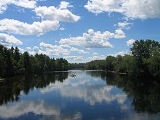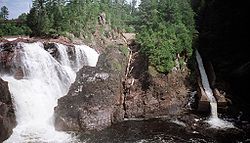
Coulonge River
Encyclopedia
The Coulonge River is a predominantly wilderness river in western Quebec
, Canada. It is 217 km long, has a drainage area of 5060 km² (source:Atlas of Canada), and runs in a general south-eastern direction from its headwaters in Lac au Barrage (situated in La Vérendrye Wildlife Reserve
) to the Ottawa River
at Fort-Coulonge, Quebec. Over that distance, it drops approximately 260 metres (853 ft) — 48 metres (157.5 ft) of that over the massive Grandes or Coulonge Chutes
, approximately 15 kilometres (9.3 mi) upstream of the confluence with the Ottawa River.
A popular river for whitewater
canoeing
enthusiasts, it is often grouped together with the Dumoine
and Noire River
s as three of a kind. The three rivers share the same watershed, and have similar whitewater characteristics. All three empty into the Ottawa River within a distance of 105 kilometres (65.2 mi) from one another.
 One of a dozen or so significant tributaries of the Ottawa River, the Coulonge was used as a waterway by native North Americans and, later, by the coureurs des bois
One of a dozen or so significant tributaries of the Ottawa River, the Coulonge was used as a waterway by native North Americans and, later, by the coureurs des bois
plying their independent trade in furs. In 1835, Scottish-born lumber baron George Bryson acquired timber rights to thousands of acres of forest in the area, including the 200 acre (80.9 ha) immediately surrounding the Grandes Chutes. To transport the squared timber safely past the falls and the 750 m (2,460.6 ft) gorge below, Bryson built a 1000 m (3,280.8 ft)-long timber slide
(a wooden chute flowing with water diverted from the head of the falls) to the calmer waters near the confluence of the Coulonge and Ottawa rivers.
For almost 150 years, the forests around the Coulonge were logged throughout the winter months until spring breakup permitted the massive log drives
which, along with similar operations throughout the Ottawa River watershed, fueled the economy of the Ottawa Valley
region from the early 19th Century through the middle of the 20th.
The last spring log drive in Canada took place on the Coulonge River in 1982. Since then, the timber from smaller-scale logging operations has been hauled out by trucks over a network of dirt roads which meander throughout the Coulonge River valley.
In 1994, a hydro-electric dam and power station was built at the head of the Grandes Chutes, leaving the Dumoine River as the last major free-flowing tributary of the Ottawa River.
Quebec
Quebec or is a province in east-central Canada. It is the only Canadian province with a predominantly French-speaking population and the only one whose sole official language is French at the provincial level....
, Canada. It is 217 km long, has a drainage area of 5060 km² (source:Atlas of Canada), and runs in a general south-eastern direction from its headwaters in Lac au Barrage (situated in La Vérendrye Wildlife Reserve
La Vérendrye Wildlife Reserve
La Vérendrye wildlife reserve is one of the largest reserves in the province of Quebec, Canada, covering 12,589 square kilometres of contiguous land and lake area . It is named after Pierre Gaultier de Varennes, sieur de La Vérendrye, a French-Canadian explorer...
) to the Ottawa River
Ottawa River
The Ottawa River is a river in the Canadian provinces of Ontario and Quebec. For most of its length, it now defines the border between these two provinces.-Geography:...
at Fort-Coulonge, Quebec. Over that distance, it drops approximately 260 metres (853 ft) — 48 metres (157.5 ft) of that over the massive Grandes or Coulonge Chutes
Coulonge Chutes
The Coulonge Chutes is a non-profit recreation park and historical exhibition area operating in Mansfield-et-Pontefract, in the Pontiac Regional County Municipality of western Quebec, Canada...
, approximately 15 kilometres (9.3 mi) upstream of the confluence with the Ottawa River.
A popular river for whitewater
Whitewater
Whitewater is formed in a rapid, when a river's gradient increases enough to disturb its laminar flow and create turbulence, i.e. form a bubbly, or aerated and unstable current; the frothy water appears white...
canoeing
Canoeing
Canoeing is an outdoor activity that involves a special kind of canoe.Open canoes may be 'poled' , sailed, 'lined and tracked' or even 'gunnel-bobbed'....
enthusiasts, it is often grouped together with the Dumoine
Dumoine River
The Dumoine River is a river in western Quebec with its source in Machin Lake near La Vérendrye Wildlife Reserve. From Dumoine Lake, the river flows almost due south off the Canadian Shield and empties into the Ottawa River, just west of Rapides-des-Joachims, Quebec, or Rolphton, Ontario...
and Noire River
Noire River
The Noire River is a river in western Quebec, Canada. It runs in a south-eastern direction into the Ottawa River at Waltham, Quebec. It is named after the dark colour of its water ....
s as three of a kind. The three rivers share the same watershed, and have similar whitewater characteristics. All three empty into the Ottawa River within a distance of 105 kilometres (65.2 mi) from one another.
History
The Coulonge River is named after Nicholas d’Ailleboust, Sieur de Coulonge, who established a trading post at the mouth of the river in the winter of 1694-95, thereby establishing the first permanent European settlement in the Pontiac region of West Quebec.
Coureur des bois
A coureur des bois or coureur de bois was an independent entrepreneurial French-Canadian woodsman who traveled in New France and the interior of North America. They travelled in the woods to trade various things for fur....
plying their independent trade in furs. In 1835, Scottish-born lumber baron George Bryson acquired timber rights to thousands of acres of forest in the area, including the 200 acre (80.9 ha) immediately surrounding the Grandes Chutes. To transport the squared timber safely past the falls and the 750 m (2,460.6 ft) gorge below, Bryson built a 1000 m (3,280.8 ft)-long timber slide
Timber slide
A timber slide is a device for moving timber past rapids and waterfalls. Their use in Canada was widespread in the 18th and 19th century timber trade. At this time, cut timber would be floated down rivers in large timber rafts from logging camps to ports such as Montreal and Saint John, New...
(a wooden chute flowing with water diverted from the head of the falls) to the calmer waters near the confluence of the Coulonge and Ottawa rivers.
For almost 150 years, the forests around the Coulonge were logged throughout the winter months until spring breakup permitted the massive log drives
Log driving
Log driving is a means of log transport which makes use of a river's current to move floating tree trunks downstream to sawmills and pulp mills.It was the main transportation method of the early logging industry in Europe and North America...
which, along with similar operations throughout the Ottawa River watershed, fueled the economy of the Ottawa Valley
Ottawa Valley
The Ottawa Valley is the valley along the boundary between Eastern Ontario and Western Quebec along the Ottawa River. The valley is the transition between the Saint Lawrence Lowlands and the Canadian Shield...
region from the early 19th Century through the middle of the 20th.
The last spring log drive in Canada took place on the Coulonge River in 1982. Since then, the timber from smaller-scale logging operations has been hauled out by trucks over a network of dirt roads which meander throughout the Coulonge River valley.
In 1994, a hydro-electric dam and power station was built at the head of the Grandes Chutes, leaving the Dumoine River as the last major free-flowing tributary of the Ottawa River.

